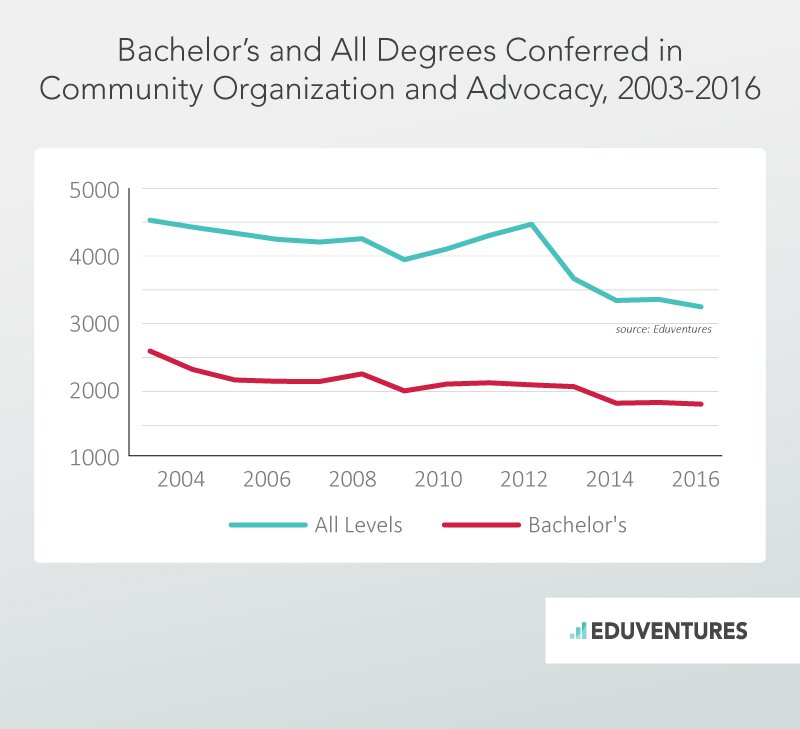Drawing on Eduventures’ 20-plus years of experience helping universities develop, launch, and assess academic programs, the Program Spotlight Series of Wake-Up Calls calls attention to best practices in program development.
We have seen growing interest in social impact programs as institutions explore program ideas that will appeal to today’s students. Such programs, spanning everything from social entrepreneurship to social justice, are designed to help students appreciate less conventional conceptions of impact, such as environmental, and may focus on a particular community seen as disadvantaged or underserved.
Traditionally, social impact programming lived in sociology or education departments with mission statements that often made direct reference to equity and access. In recent years, social impact programming has extended into many areas of the institution including business, management, and engineering.
But does it make sense for institutions to launch dedicated social impact programs?
The Next Generation
Given what we know about current student interests and expectations, it is not surprising that institutions continue to explore launching or expanding social impact programs.
Nearly one-fifth (17%) of students entering college have an “Exploration and Meaning” mindset, according to our 2017 Prospective Student Survey analysis. These are traditional undergraduate students who believe: “College is all about finding meaning in your life and sharing it with others around the world.” When it comes to career goals, they are concerned with finding a career that makes an impact on the world.
This “social impact” mentality may be central to the college selection process for “Exploration and Meaning” students, but also characterizes last year’s freshman class. According to the Higher Education Research Institute’s (HERI) 2016 Freshman Survey, students today are more politically polarized and place greater importance on social values than at nearly any other time in the 51 years of the survey. Many students expect to be community leaders of some sort (43%), and, more than ever before, they plan to help others who are in difficulty (78%). These characteristics have been gradually growing over the past decade, and are more pervasive than in late 1960s and early 1970s, a high watermark of social activism.
Given this level of interest, one might expect to see significant growth in degrees awarded in community organization and advocacy. In fact, if one considers this the most obvious subject code, federal data shows long-term decline at Bachelor’s level and across all degree levels combined.
Source: Eduventures analysis of IPEDS data. CIP code 44.02 “Community Organization and Advocacy.”
Traditional age undergraduates appear more focused on social impact than ever, yet few opt for a major in this area. The challenge for institutions is to balance dedicated degree programs with other methods of engaging socially conscious students.
Generally, institutions have responded in three ways.
- A curricular thread. Infusing social impact at the course level. Faculty and departments incorporate concepts into their curriculum. This might be a grassroots effort, or a core part of an institution’s mission and strategic plan.
- For example, San Francisco State University seeks to infuse social justice education into their curriculum.
- Many schools of education promote social change in their curricula. Consider the mission of Boston College’s Lynch School of Education, which they attest is implemented through teaching, research, and service: “To enhance the human condition, expand the human imagination, and make the world more just—that’s the mission driving the work of our faculty and students.”
- An interdisciplinary focus. Create courses, minors, interdisciplinary centers that may include experiential education components and enable students from any major to engage with social impact concepts and experiences. Again, faculty or departments might lead this strategy. It may be a clearer pathway for career-focused students who want to help others or impact the world with their career, by helping them integrate their major, in whatever field, with social impact, social justice, social entrepreneurship, etc. Consider the following examples:
- “Social Impact Core” offered to undergraduate business majors at NYU.
- The Center for Social Justice Research, Teaching and Service at Georgetown, which provides a list of related courses across campus.
- Engineering for Social Innovation at Georgia Tech that supports projects focused on improving “the lives of the under-privileged domestic population or people at the bottom of pyramid in the developing world,” and gives students opportunities to get involved.
- A new major. Developing a wholly separate degree program likely requires the most investment and the greatest risk in terms of faculty, recruitment and marketing. Determining where the program resides, what exactly it offers, and what the outcomes will be, are essential for recruiting students and measuring success of the program. Established examples include:
- UMass Amherst’s University Without Walls offers an advocacy and social justice program for non-traditional learners.
- Master of Arts in Social Impact (Social Entrepreneurship) at Claremont Lincoln University.
Institutions should identify the mindsets and interests of students at their institution and explore how best to support, as well as develop and challenge, their interest in, and aspirations for, social impact. If you’re considering a new social impact program or emphasis, we’re here to support you in the research and assessment process.
For more on Student Mindsets, stay tuned for the upcoming release of Eduventures latest In-Depth Report, 2017 Prospective Student Survey: Mindsets During Search this Thursday, August 17. If you’d like to receive the PSS Deep Dive report, please contact Client Services.


